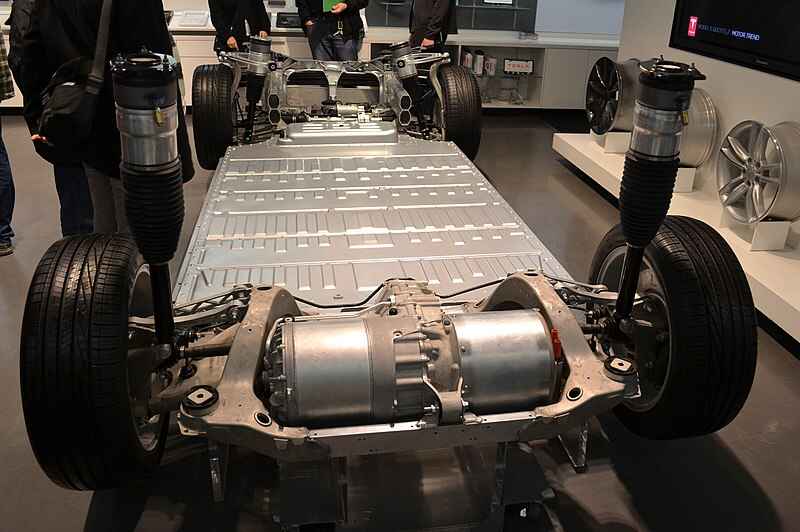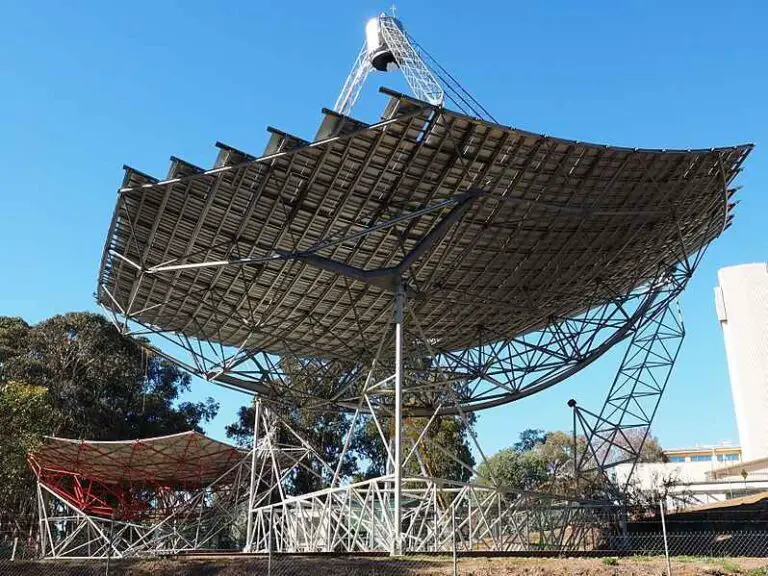5 Electric Car Components and Functions Explained
Electric car components are; power inverter, traction battery pack, electric traction motor, electric power control unit, and on-board charger/port.
There are over a thousand parts in an electric car, however, the above-listed are most prominent in terms of importance, toward to the overall functioning of the car.
This article discusses the components of electric cars, and their functions, as follows;
1). Power Inverter (as one of the Electric Car Components)
A power inverter (or DC-AC converter) is a device whose core function is to convert electricity from direct current (DC) form to alternating current (AC) form [5].
An inverter in an electric car is the part of the traction assembly that modifies stored energy from the battery before it is transmitted to the traction motor, by converting outflowing DC current to usable AC current for the vehicle [1].
The role of the inverter in an electric car is very crucial because it controls power supply to the car, from the battery. Inverters also occur in hybrid vehicles that use batteries, where they play an identical role to their role in battery-electric vehicles.
The inverter works by rapidly switching the current from the battery, thereby changing the frequency and voltage-amplitude of the current. By controlling supply frequency, inverters control the speed of rotation of the electric motor, which in turn controls the speed of the vehicle.
Inverters in electric cars must be able to deliver high-power output, and must be thermo-mechanically resilient.
The minimum required output of the inverter depends on the design of the vehicle and the performance of other components.
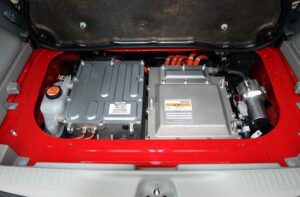
2). Traction Battery Pack
The traction battery or electric vehicle battery (EVB) is the main energy storage system in an electric vehicle, whose role is to accumulate and store power during every recharge of the vehicle.
It is called 'traction' battery because it is part of the vehicle's traction system and supplies stored energy to the wheels for their motion.
The difference between traction batteries and normal batteries is the depth of recharge, as traction batteries are built based on deep-cycle technology to enable them supply significant amount of power for extended periods of time.
A traction battery pack works by continuous cycles of recharge and discharge, whereby power from a current source is converted to storable chemical energy in the battery, and released by subsequent re-conversion to DC electric power.
The battery works together with the inverter to convert its DC output to AC output that the vehicle can use.
The main type of battery used in traction systems is lithium-ion battery, which is usually utilized as large numbers of assembled units that form the battery pack. Lithium Iron phosphate (LFP) is an example of a reliable lithium-ion battery for EVs [3].
3). Electric Traction Motor (as one of the Electric Car Components)
Along with the batteries, the electric motor is a key component of an EV electric traction system.
The electric traction motor is the component of an electric car whose function is to convert electric current from the battery to mechanical energy of rotation, that is used to move the vehicle.
Traction motors operate by a working principle that is inverse to that of electric generators.
Inside an electric car motor are subcomponents like the rotor, stator, and conducting wires, which work together to induce mechanical rotation by the electromagnetic effect.
Types of traction motors used in electric cars are; permanent magnet synchronous motor (PMSM), switched reluctance motor (SRM), brushless DC motor and three-phase induction motor [4].
Brushless induction motors are commonly used and widely accepted in electric vehicles due to low maintenance requirements, cost, and high reliability compared to other types of motors [2].
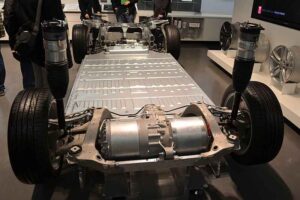
4). Electric Power Control Unit (EPCU)
The electric power control unit in electric vehicles, also known as electric control unit (ECU), power control unit (PCU) or electric vehicle control unit (EV-ECU); is a system that is designed to control the operation of all electric-powered parts of the vehicle.
It is called system, rather than component here, because it comprises of multiple components that work together simultaneously to achieve the same objective.
Parts of the electric power control unit in an electric vehicle are; low voltage DC-DC converter (LDC), vehicle control unit (VCU), and inverter.
The inverter converts DC from the battery to AC that is used for locomotion; the low voltage DC-DC converter is used to modify high DC from the battery, to low DC that is suitable for powering small electronic components of the vehicle; while the vehicle control unit is used to regulate power supply, charging, regenerative braking and torque.
5). On-board Charger and Port (as one of the Electric Car Components)
The on board charger (OBC) in electric vehicles is a component that is designed to convert AC from an external power source to DC that is stored in the vehicle's traction battery.
On-board charger differs from off-board charger in EVs, by being equipped specifically for low-voltage AC charging, whereas the off-board charger is equipped for high-voltage AC charging, as well as DC charging. Also, some subcomponents of the on board charger may mediate between the off-board charger and the battery in some vehicles.
Charge port in electric vehicles is the terminal from which electric power can be transmitted into the vehicle for storage. It may be any of various designs made to fit different types of plugs.
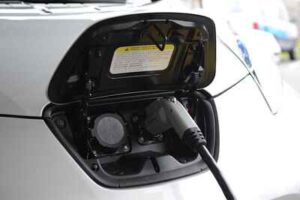
Conclusion
Electric car components are;
1. Power Inverter
2. Traction Battery Pack
3. Electric Traction Motor
4. Electric Power Control Unit (EPCU)
5. On-board Charger and Port
References
1). Amry, Y.; Elbouchikhi, E.; Le Gall, F.; Ghogho, M.; El Hani, S. (2022). "Electric Vehicle Traction Drives and Charging Station Power Electronics: Current Status and Challenges." Energies 15(16):6037. Available at: https://doi.org/10.3390/en15166037. (Accessed 15 March 2023).
2). Chan, C.C.; Cheng, M. (2012). "Vehicle Traction Motors." In: Meyers, R.A. (eds) Encyclopedia of Sustainability Science and Technology. Springer, New York, NY. Available at: https://doi.org/10.1007/978-1-4419-0851-3_800. (Accessed 15 March 2023).
3). Friedrischková, K.; Vala, D.; Horák, B. (2015). "Testing of the traction batteries in electric vehicles and their further use." IFAC-PapersOnLine 48(4):272-277. Available at: https://doi.org/10.1016/j.ifacol.2015.07.046. (Accessed 15 March 2023).
4). Karthik, S. H. (2019). "Types of Motors used in Electric Vehicles." Available at: https://bit.ly/3YQ0Rou. (Accessed 15 March 2023).
5). Mahfouz, H.; Sayed, K.; Abo-Khalil, A. G.; Almutairi, A. (2022). "A Review of DC-AC Converters for Electric Vehicle Applications." Energies. Available at: https://doi.org/10.3390/en15031241. (Accessed 15 March 2023).
